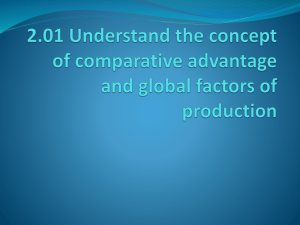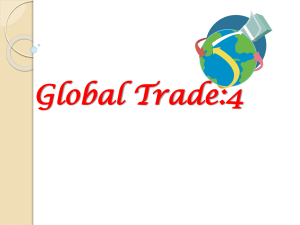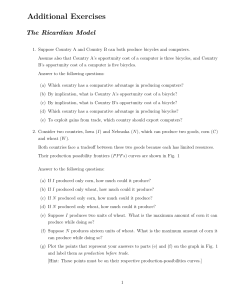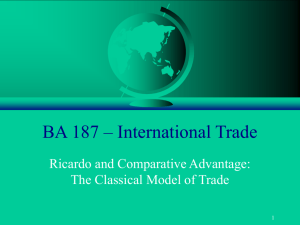Homework 1
advertisement
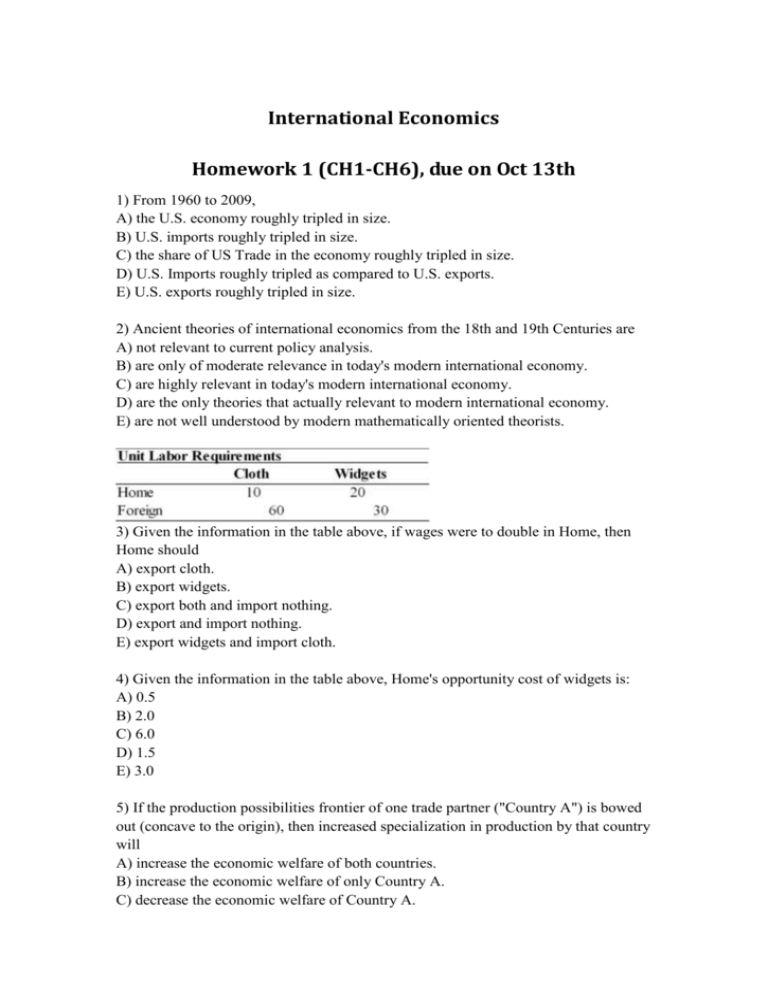
International Economics Homework 1 (CH1-CH6), due on Oct 13th 1) From 1960 to 2009, A) the U.S. economy roughly tripled in size. B) U.S. imports roughly tripled in size. C) the share of US Trade in the economy roughly tripled in size. D) U.S. Imports roughly tripled as compared to U.S. exports. E) U.S. exports roughly tripled in size. 2) Ancient theories of international economics from the 18th and 19th Centuries are A) not relevant to current policy analysis. B) are only of moderate relevance in today's modern international economy. C) are highly relevant in today's modern international economy. D) are the only theories that actually relevant to modern international economy. E) are not well understood by modern mathematically oriented theorists. 3) Given the information in the table above, if wages were to double in Home, then Home should A) export cloth. B) export widgets. C) export both and import nothing. D) export and import nothing. E) export widgets and import cloth. 4) Given the information in the table above, Home's opportunity cost of widgets is: A) 0.5 B) 2.0 C) 6.0 D) 1.5 E) 3.0 5) If the production possibilities frontier of one trade partner ("Country A") is bowed out (concave to the origin), then increased specialization in production by that country will A) increase the economic welfare of both countries. B) increase the economic welfare of only Country A. C) decrease the economic welfare of Country A. D) decrease the economic welfare of Country B. E) not affect the economic welfare of either country. 6) If one country's wage level is very high relative to the other's (the relative wage exceeding the relative productivity ratios), then if they both use the same currency A) neither country has a comparative advantage. B) only the low wage country has a comparative advantage. C) only the high wage country has a comparative advantage. D) consumers will still find trade worth while from their perspective. E) it is possible that both will enjoy the conventional gains from trade. 7) The Ricardian two-country two-good model predicts that there are potential benefits from trade, but not A) the effect of trade on income distribution. B) the mechanism that determines which country will specialize in which good. C) when one country has an absolute advantage in the production of both goods. D) when one country has significantly lower wages than the other country. E) when both countries have the same types of technology available. 8) Japan's trade policies with regard to rice reflect the fact that A) japanese rice farmers have significant political power. B) Japan has a comparative advantage in rice production and therefore exports most of its rice crop. C) there would be no gains from trade available to Japan if it engaged in free trade in rice. D) there are gains from trade that Japan captures by engaging in free trade in rice. E) Japan imports most of the rice consumed in the country. 9) A country that does not engage in trade can benefit from trade only if A) its wage rate is below the world average. B) it employs a unique technology. C) it has an absolute advantage in at least one good. D) pre-trade and free-trade relative prices are not identical. E) pre-trade and free-trade relative prices are identical. 10) In modern economies, A) restrictions on international labor mobility are common. B) labor is far more mobile internationally than capital. C) restrictions on international labor mobility are rare. D) labor is far more mobile internationally than it is intra-nationally. E) outsourcing increases international labor mobility. 11) According to the Heckscher-Ohlin model, the source of comparative advantage is a country's A) factor endowments. B) technology. C) advertising. D) human capital. E) political system. 12) The assumption of diminishing returns in the Heckscher-Ohlin model means that, unlike in the Ricardian model, it is likely that A) comparative advantage will not determine the direction of trade. B) countries will benefit from free international trade. C) countries will consume outside their production possibility frontier. D) countries will not be fully specialized in one product. E) global production will decrease under trade. 13) Which of the following is an assertion of the Heckscher-Ohlin model? A) The wage-rental ratio is determined by relative product prices. B) An increase in a country's labor supply will increase production of both the capital-intensive and the labor-intensive good. C) In the long-run, labor is mobile and capital is not. D) Factor price equalization will occur only if there is costless mobility of all factors across borders. E) Factor endowments determine the technology that is available to a country, which determines the good in which the country will have a comparative advantage. 14) A country cannot produce a mix of products with a higher value than where A) the isovalue line intersects the production possibility frontier. B) the isovalue line is tangent to the production possibility frontier. C) the isovalue line is above the production possibility frontier. D) the isovalue line is below the production possibility frontier. E) the isovalue line is tangent with the indifference curve. 15) If the ratio of price of cloth (PC) divided by the price of food (PF) increases in the international marketplace, then A) the terms of trade of cloth exporters will improve. B) all countries would be better off. C) the terms of trade of food exporters will improve. D) the terms of trade of all countries will improve. E) the terms of trade of cloth exporters will worsen. 16) The Services sector has been steadily rising in relative importance in GDP of the United States, as well as elsewhere around the world. Since "services" have been identified as "non-tradables" (e.g., it is difficult to export haircuts), it may be argued that this trend will likely slow the rapid growth in international trade. Discuss. 17) Use the information in the table below to answer the following questions. (a) Does either country have an absolute advantage in the production of wheat or beef? Explain. (b) What is the opportunity cost of wheat in each country? (c) What is the opportunity cost of beef in each country? (d) Analyze comparative advantage and opportunities for trade between the U.S. and Argentina.

